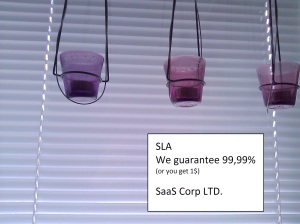Why SLA does not make sense in the Cloud?
May 25, 2011 1 Comment
What do you really want to accomplish with Service Level Agreement (SLA)? To punish or to get the best support available, as soon as possible? With the traditional on premise software if there is a problem you are pretty much all alone with it.The time and the money between binary hitting the fan and fan being fixed is solely coming from your pocket. In the traditional on-premise or dedicated server software environment SLA makes sense. You need to have some leverage and certainty that your software provider is at least mildly interested in fixing your problem.
When “Cloud Computing” is hit with speed bumps the whole Internet is holding its breath. Latest example being Amazon incident on April 21 2011. If SaaS service is not up and running SaaS firm is losing lot of money and very fast. Most of the SaaS firms have monthly recurring revenue model and customers can cancel subscription within one month notice. This means that customers can vote with their wallet. So you can be sure that a SaaS firm gives its fullest attention in order to get their SaaS service up and running as soon as possible. If your provider has fully Clouded its technology (so-called multitenancy), your application instance will be fixed as soon as service is fixed. No one is getting special treatment. Not good or bad. So there is no need to be fearful about your account is not running while others are.

You should be able to see if your Cloud is in storm or calm.
With a proper SLA the damages and indemnification are somehow fixed to the amount of money you pay for the software, services included. With SaaS firms your monthly – and even yearly fees – are quite small amount of money and so are the potential liquidated damages. This means that, for example, 10% indemnification of the subscription value is merely a nominal sum. For example, if a SaaS service would cost you 59$ yearly subscription it would entitle you 50 cent compensation for one month downtime. And before you try to negotiate higher indemnification, talk to you own lawyer and ask if you should sign a contract that has liquidated damages clause over 100% of contract value. Next imagine you are asking for it from SaaS firm? And guess the response. My point is that there is no realistic way to imagine a SLA between you and SaaS provider that would have real monetary indemnification. The real penalty for a SaaS provider is in the form of loss of income, increased churn, and negative publicity. Any serious SaaS provider will do everything to avoid this.

Seek for transparency instead of indemnification.
What I am trying to say is that instead of asking what SLA levels you receive and what kind of compensation is possible, ask what your SaaS provider is doing to minimize the downtime. It does not make sense to try to get SLA agreement as tight as possible. It makes more sense to make sure that provider is “all in” with the cloud. If service you are using truly has significant monetary value for you provider it will make sure that it will run as smoothly as humanly possible.
Make them prove that they know what they are doing, but not with a SLA. Ask about security, availability, recovery and how you can monitor uptime. For example Azure (Service Dashboard), AzureWatch and Sopima Oy provide RSS feeds to its customers to give transparency of its service levels.
Focus on finding the signs of preemption, transparency and security – instead of indemnification in the SLA.
PS. If you want to know that 10 questions you should ask from your SaaS vendor and what are the correct answers go here.
PS2. Originally posted in my personal blog.

